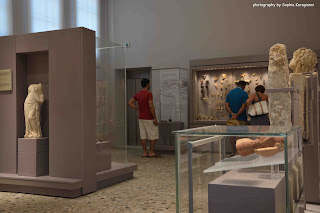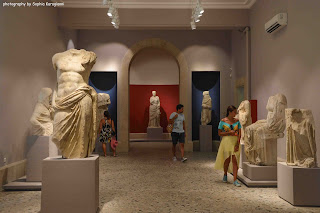 |
| το αρχαιολογικό μουσείο τραβηγμένο από την ταράτσα της Αίγλης |
Στο Αρχαιολογικό Μουσείο της Κω βρίσκονται συγκεντρωμένα όλα τα ευρήματα που ήρθαν στο φως κατά τις ανασκαφές που διεξάγονται στο νησί από τις αρχές του αιώνα μέχρι σήμερα, κυρίως από τους αρχαιολογικούς χώρους της Αγοράς και το Δυτικό αρχαιολογικό χώρο, καθώς και από μεμονωμένα μνημεία, όπως το Βωμό του Διονύσου, το Ωδείο και τη Ρωμαϊκή Οικία (Casa Romana).
Η έκθεση των γλυπτών που λειτουργεί σήμερα στο Μουσείο συγκεντρώνει έργα που χρονολογούνται από τα ελληνιστικά έως τα υστερορωμαϊκά χρόνια και αποσκοπεί να παρουσιάσει στο ευρύτερο κοινό τα σημαντικότερα έργα της γλυπτικής που προέρχονται από την Κω.
Το κτιριακό διώροφο οικοδόμημα στην πλατεία Ελευθερίας στο οποίο στεγάζεται το σημερινό αρχαιολογικό Μουσείο της Κω, είναι διατηρητέο μνημείο (από το 1986) της εποχής της Ιταλοκρατίας, κτισμένο το 1936. Αποτελείται από υπόγειο, ισόγειο, ημιώροφο στο ΝΑ τμήμα του κτηρίου και όροφο. Τη βάση του περιθέει ορθομαρμάρωση από αμυγδαλόπετρα (είδος τοπικού τραβερτίνη), τα άκρα της οποίας στέφονται με κυμάτιο. με παρόμοια επένδυση τονίζονται τα παράθυρα και οι θύρες.
 |
| η κεντρική είσοδος του μουσείου πριν και μετά τις παρεμβάσεις |
Στην ανατολική όψη ανοίγονται έξι παράθυρα, τρία τοξωτά στον όροφο και τρία υψηλότερα ορθογώνια στο ύψος του ημιώροφου. Η δυτική πλευρά του κτιρίου εκτείνεται σε μεγαλύτερο μέρος από την ανατολική, λόγω της προεξέχουσας κυκλικής απόληξης στο βορειότερο άκρο του υπογείου και του ισογείου. Το ευρύχωρο προεξέχον δώμα αυτής της απόληξης στον όροφο συνδυαζόταν με στενότερο καμπυλόγραμμο εξώστη.
 |
| το μουσείο, τραβηγμένο από το μιναρέ του Τζαμιού Defterdar |
Στον προθάλαμο ξεχωρίζει το υπερφυσικό κεφάλι της Ήρας (2ος αι. π.Χ.), το ανάγλυφο με παράσταση κεφαλής ίππου, και επιτύμβιος κυλινδρικός βωμός με μαρμάρινο βάτραχο από διακόσμηση κρήνης.
 |
| πριν και μετά |
 |
| πριν και μετά |
 |
| λεπτομέρειες από το άγαλμα του Ερμή |
 |
| με τα μάτια του Ερμή |
 |
| το μικρό ψηφιδωτό με τα ψαράκια της Casa Romana |
 |
| δεξιά του Ιπποκράτη διακρίνεται άγαλμα γυναίκας της ύστερης ελληνιστικής εποχής. Ξεχωρίζουν οι πτυχώσεις του ιματίου της. |
 |
| λεπτομέρειες από το πρόσωπο του αγάλματος που αποδίδεται στον Ιπποκράτη |
 |
| αποξηραμένα σύκα |
 |
| όπλα και εργαλεία |
 |
| κοσμήματα |
 |
| νομίσματα |
 |
| ευρήματα από το Σπήλαιο της Άσπρης Πέτρας |
 |
| ανάγλυφο με παράσταση Χάριτων |
Πηγή: http://odysseus.culture.gr/h/1/gh151.jsp?obj_id=3410
ARCHAEOLOGICAL MUSEUM OF KOS
The Archaeological Museum of Kos houses all the finds brought to light during excavations carried out on the island from the beginning of the century until today, mainly from the archaeological sites of the Agora and the Western archaeological area, as well as from individual monuments, such as the Altar of Dionysos, the Odeon and the Roman House (Casa Romana).
The exhibition of sculptures currently on display in the Museum brings together works dating from the Hellenistic to the Late Roman period and aims to present to the wider public the most important works of sculpture originating from Kos.
The two-storey building in Eleftherias Square, which houses today’s Archaeological Museum of Kos, has been a listed monument (since 1986) from the period of Italian rule, built in 1936. It consists of a basement, a ground floor, a mezzanine in the SE section of the building, and an upper floor. Its base is clad in marble facing of amygdalopetra (a kind of local travertine), crowned with a moulding. Similar cladding highlights the windows and doors.
On the eastern façade, six windows open, three arched on the upper floor and three taller rectangular ones at the mezzanine level. The western side of the building extends further than the eastern, due to the projecting circular end at the northernmost part of the basement and ground floor. The spacious projecting terrace of this end on the upper floor was combined with a narrower curvilinear balcony.
In the vestibule, the colossal head of Hera (2nd c. B.C.), the relief with a horse’s head, and a cylindrical funerary altar with a marble frog from the decoration of a fountain stand out.
Upon entering, the visitor encounters the most impressive part of the museum, the atrium and the peristyle.
Before and after
In the middle of the peristyle hall dominates the mosaic of the “notables” of Asklepios. Numerous statues in the peristyle surround the mosaic floor representing the arrival of Asklepios in Kos (3rd c. A.D.).
In the atrium is depicted a rich Roman villa and the sculptural decoration from the House of Europe.
At the center of the peristyle was placed—transferred from the eastern hall—the statue of Hermes seated, with winged petasos, winged sandals and caduceus. Beside him stands a ram with reddish-dyed fleece (2nd c. A.D.).
Also in the peristyle stands the table support with a depiction of a griffin (mid-2nd c. A.D.) [Reference to griffins and their significance can be found in my post about the Dioikitirio of Kos].
Another mosaic of the Hellenistic period, depicting a marine seabed, which decorated the north wall of the peristyle and originates from the restored Roman House (Casa Romana), I was unable to locate.
The small mosaic with the little fish from the Casa Romana
In the western hall, Hellenistic statues are displayed, most of which were found stored in the porticoes of the Odeon, with the theme “Sculpture as an expression of the dynamics of the city-state (4th–1st c. B.C.)”: a statue of an athlete (3rd c. B.C.), female figures wearing the famous Koan garments, a head of Alexander, a male torso, etc.
Details of the face of the statue attributed to Hippocrates
In the same hall are exhibited Hellenistic statues of Aphrodite, Nymphs, Tyche (1st c. B.C.), and a group of ephedrismos (2nd c. B.C.). I missed the small figurine of Marsyas, who, hanging from his wrists on a tree, undergoes his torment, as it was my favorite exhibit and is no longer on display. I hope it can be seen on the upper floor.
The first floor of the building hosts the large collection of vases and other small finds from Kos, which has recently been opened to the public.
The museum will be equipped with an elevator and access for people with disabilities. Admission is, for now, free, but soon a combined ticket will be introduced for four archaeological sites in Kos, with opening hours from 07:00 a.m. to 8:30 p.m. The Archaeological Museum of Kos falls under the jurisdiction of the Ephorate of Antiquities of the Dodecanese.
Relief depicting the Charites
Following the earthquake of July 21, some of the exhibits of the Museum suffered damage and were absent from their places due to restoration for a long time. I am not aware if they have returned to their places yet.











































Δεν υπάρχουν σχόλια:
Δημοσίευση σχολίου